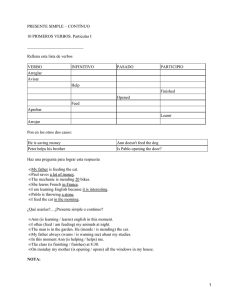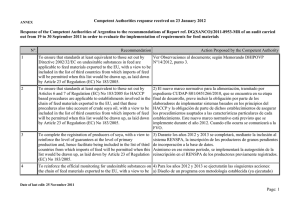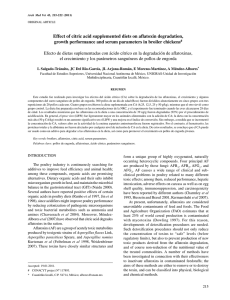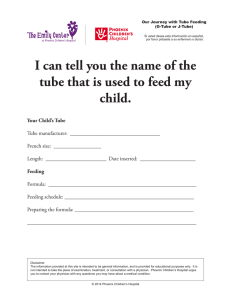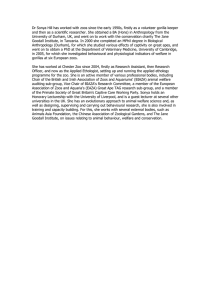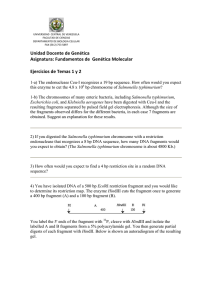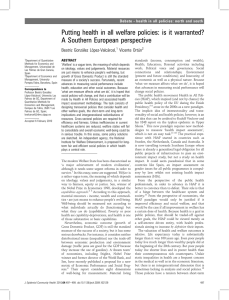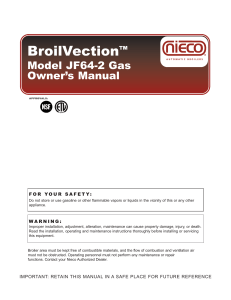Caroline Lindholm - 2015 - The physiology of feed restriction and its welfare implications
Anuncio
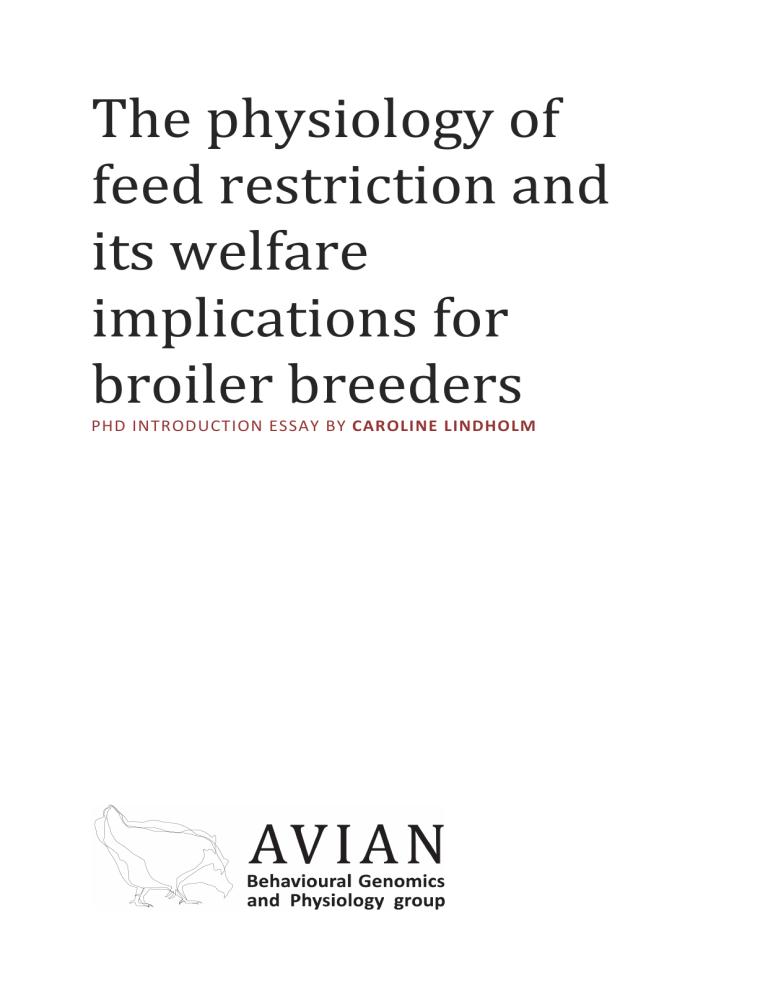
The physiology of feed restriction and its welfare implications for broiler breeders PHD INTRODUCTION ESSAY BY CAROLINE LINDHOLM Feed restriction and welfare of broiler breeders | Caroline Lindholm Introduction Broiler chickens have been intensively selected for efficient and rapid weight gain and currently reach their slaughter weight at five weeks of age (Zuidhof et al 2014). While this allows for a highly cost-efficient meat production with relatively little negative environmental impact, it also presents these birds with several serious health problems resulting from the quick growth. These problems are especially prominent in broiler breeders, the parents of meat production broilers, who are kept alive until around 60 weeks of age and must be in good reproductive health (Decuypere et al 2010). To reduce the growth rate and increase the health status of breeders, these are typically heavily feed restricted during rearing and may only receive 25-33% of their expected ad libitum intake during the most extreme periods. Differences in estimated restriction level depends on whether the comparison is based on chronological age or body weight (Katanbaf et al 1989; Savory et al 1996). It is generally assumed that this extensive feed restriction is a major stressor for the broiler breeders, who none the less must be starved this way to avoid overweight-related health problems, such as lameness, reproductive disorders and increased mortality (D’Eath et al 2009). This problem is known as the broiler breeder paradox (Decuypere et al 2010). Defining animal welfare The idea of animal welfare comes from ethical and emotional considerations of how we use animals, and even though Duncan (2002) reports that most people from developed countries have an intuitive agreement on what constitutes poor welfare the scientific community is still struggling to find a suitable definition of the concept (Duncan 2002; Korte et al 2007). Many have assumed a negative correlation between stress and welfare, often using physiological parameters such as circulating glucocorticoid levels to quantitate stress. This approach has received much criticism both because stress can be associated with positive emotional states and because glucocorticoid secretion is a normal physiological response to challenging situations and can instead be seen as a protective mechanism against stress (Veissier & Boissy 2007; Korte et al 2007). It has also been argued that the physiological parameters used to quantitate stress levels may not accurately reflect the level of stress experienced by the animal, for example glucocorticoid secretion is down-regulated by negative feedback mechanisms that may mask the true extent of stress in a situation with poor welfare (Veissier & Boissy 2007). According to the feeling-based school of thought on animal welfare the physiological primary needs of an animal are actually not very interesting at all. Its proponents argue that a primary need in the form of e g a nutrient deficiency is itself not welfare-decreasing unless it gives rise to the secondary feeling of hunger. By this reasoning, welfare should always be assessed based on the emotional status of animals. While there are indirect methods, such as preference testing, for assessing this it is naturally more complicated to measure than physiological parameters. There is also the issue of whether, and to what extent, positive emotions can be used to balance negative ones in cases where negative emotions cannot be avoided (Duncan 2002). More recent definitions of animal welfare tend not to focus on keeping animals entirely free of negative emotions, but rather granting animals the freedom to react appropriately to stressful situations in such a way that they experience a decrease in negative feelings. Negative emotional states may for example be expected while social hierarchies are being established, although these hierarchies will later lead to better coping abilities. According to this point of view, the most important factor for animal welfare is that the animal is physiologically and behaviourally equipped to adapt to environmental demands. Welfare assessments based on static parameters or the reaction to acute foreign stressors are therefore not very 1 Feed restriction and welfare of broiler breeders | Caroline Lindholm relevant to the welfare the animal experiences on a daily basis (Ohl & van der Staay 2012). Based on the concept of allostasis, a fairly recent term focusing on the ever-changing requirements to maintain homeostasis, good welfare is now more often understood not as freedom from challenges but rather as the ability of animals to anticipate and adapt to changes in their environment. Good welfare is then achieved by only exposing the animals to environments that are within their coping abilities (Korte et al 2007). The use of feed restriction in animal husbandry Over-eating and resulting obesity is a problem in many animal species living in different forms of captivity, and can have serious detrimental health effects unless handled properly. The use of feed restriction to prevent over-eating is most pronounced in dry sows (Sus scrofa) and young broiler breeders (Gallus gallus), reaching levels of 50% and 33% of ad libitum feed intake respectively in the most extreme cases. It is widely accepted that these levels of feed restriction will leave the animals chronically hungry, and in 2001 the EU implemented legislation stating that sows should be provided with bulky feed so that they can still perform their natural feeding behaviours (D’Eath et al 2009). While feed restriction in broiler breeders has been identified as one of the major welfare issues among production animals, the problem has proven difficult to solve. During the last 50-odd years broiler chickens have been intensively selected for rapid growth and low feed conversion ratios, and the time required to reach slaughter weight has been reduced from several months to only five weeks (Zuidhof et al 2014). Their rapid growth is not only coupled with severe strain on the skeletal and cardiovascular systems, but has also led to a large increase in reproductive disorders. Unfortunately, the reproductive issues in broilers appear to be causally related to their rapid growth. The adiposity that inevitably occurs in ad lib-fed broilers affects their capacity for steroid-production, which in turn induces follicular hypersensitivity and leads to problems with follicular growth and differentiation (Decuypere et al 2010). The endocrine profile that results from the high level of adiposity also leads to an excess of triglycerides and fatty acids in non-adipocytes, which results in ovarian dysfunction and cell death due to lipotoxicity (Chen et al 2006). In addition, over-eating also reduces the sensitivity of the pituitary gland to luteinizing hormone-releasing hormone (LHRH) and leads to premature maturation of the HPA axis (Bruggeman et al 1999; Decuypere et al 2010). Diurnal rhythms in body temperature and plasma glucose levels in chickens seem to be entirely dictated by feeding regime, and not follow any intrinsic pattern (Raheja 1973; de Jong et al 2002; Savory et al 2006). While ad libitum-fed chicks do not show any diurnal variations at all, feed-restricted chicks appear to reduce their metabolic rates by lowering heart rate, blood pressure and body temperature, especially during the night (Katanbaf et al 1989; de Jong et al 2002; Savory et al 2006). As these parameters are direct reflections of the feeding status in chickens, they are not suitable as measurements of physiological stress. Ad lib-fed chickens are often used as control group in feed restriction studies, but this practice has been questioned for these very reasons (de Jong et al 2002). Signs of habituation to feed restriction Many studies have found signs of habituation to prolonged feed restriction in broiler breeders. Katanbaf et al (1989) found that young chickens (33-35 days of age) responded to extended fasting periods with heightened H/L ratios, while the same treatment had no such effect in older chickens (151-153 days). Hocking et al (1996) reported increases in behaviours associated with feeding frustration such as preening and non-eating oral behaviours in feed-restricted chicks at 6 weeks of age, but these differences were no longer seen in comparison with ad lib-fed chicks at 12 weeks. It is remarkable that habituation appeared 2 Feed restriction and welfare of broiler breeders | Caroline Lindholm to have taken place already at 12 weeks of age as feed-restriction has its largest growth-retarding effect in the 7-15 week period (Bruggeman et al 1999). Others have found that initially non-functional aggressive behaviours were directed towards competing for feed at 8 weeks of age (Mench 2002). In comparing a commercial restriction programme (feeding level undisclosed) with their own restriction regimes (25-100% of ad libitum) Hocking et al (1996) also found that even when two feeding regimes led to equivalent body weights at the end of rearing, physiological and behavioural stress parameters such as water intake, H/L ratios, circulating corticosterone (CORT) and basophil counts indicated lower stress levels in birds subjected to more gradual changes in feeding level (Hocking et al 1996). While some have found plasma corticosterone levels to remain elevated for > 10 weeks in both male and female chicks (Mench 2002), there is also data suggesting that the adrenocortical response attenuates to feedrestriction after a number of weeks (Rees et al 1985). Birds that are normally fed on an intermittent feeding regime where food is not available every day react to prolonged fasting with a smaller increase in corticosterone levels than do ad lib-fed chicks (Figure 1). Rees et al (1985) concluded that this is the result of reduced endogenous ACTH secretion in response to the persistently high baseline CORT levels leading to starvation-specific attenuation of the stress response, and not the result of a more general HPA axis modification. Feather pecking is a common problem behaviour in chickens and has often been associated with feed restriction. Morrissey et al (2014) found that birds fed every other day were initially more prone to feather-peck during rearing, but this behaviour decreased after 11 weeks of age and disappeared completely in the laying phase. All in all, behavioural parameters seem to be pretty consistent although breed differences in e g activity level and the propensity for pecking behaviours have been found (de Jong et al 2003), while the physiological response to feed restriction appears to differ more between individuals than between breeds (Zuidhof et al 1995; de Jong et al 2003). The different physiological responses to feed restriction within the same flock of birds is typically explained by an increase in feed competition (Zuidhof et al 1995; Aviagen 2013). a) b) Plasma CORT (ng/ml) 4.0 Fed ad lib. Fasted ad lib. Fed intermitt. Fasted intermitt. 30 Ad libitum Intermittent Fold change in plasma CORT 5.0 3.0 2.0 1.0 0.0 25 20 15 10 5 0 Fed After 48 h fast exercised rested control ACTH saline control Figure 1. (a) Plasma CORT response to a 48 hour fasting period in chickens previously fed ad libitum (blue bars) or intermittently (orange bars). While intermittently fed birds had a higher baseline level their response was lower showing a roughly 2.5-fold increase in comparison with the 10-fold increase seen in ad lib birds. (b) However, when birds were stressed either by forced exercise or injection of ACTH (3 IU/kg) Rees et al (1985) found that the magnitude of the CORT response varied depending on the current feeding status of the birds and not on the feeding regimen that they were habituated to. Rees et al (1985) took this to mean that the attenuation of the CORT response seen in (a) is fasting-specific and not the result of HPA habituation. The lower relative increase in CORT when stressed by other means (b) is explained by feedback inhibition due to high baseline levels of circulating CORT. Adapted from Rees et al (1985), Figures 2-3. Feed restriction in the future Since the early 1990s the most accurate predictor of success in the chicken meat industry is no longer considered to be the amount of meat produced per chick but rather the amount of meat produced per breeder (Decuypere et al 2010). While this can be expected to increase the industry’s focus on the welfare of the breeder generation, improvements in the parental generation still has very little economic impact 3 Feed restriction and welfare of broiler breeders | Caroline Lindholm on production and can easily be overlooked. For example, breeders only eat 5% of the feed consumed by the two ultimate generations and depending on the final slaughter weight the cost of the chicks themselves may make up as little as 12.5% of the total cost of broiler rearing. Because increased profits in the chicken meat industry still primarily come from increasing feed conversion ratios and the percentage of breast meat, feed restriction in the breeder generation can be expected to increase rather than decrease in the future (Decuypere et al 2010). While a good feed conversion ratio is problematic for breeders during rearing, it has also been shown to make them more productive as layers (Zuidhof et al 1995). As an alternative to feed restriction, there have been suggestions to use dwarf broiler hens which can be fed ad libitum and still maintain reproductive abilities. Because the dwarf-gene is sex-linked, dwarf hens can give rise to normal fast-growing broiler chicks if mated with normal roosters (Decuypere et al 2010). While dwarf hens can be expected to experience better welfare during rearing as they are not exposed to chronic hunger, the difference in size between mates would be a problem in the laying phase and may require an unwanted shift to artificial insemination (Decuypere et al 2010). Dwarf breeders also tend to show poor egg production and higher adiposity than normal birds. This adiposity is also seen in their offspring, and unwanted in slaughter broilers (Leeson & Summers 1985). Dawkins and Layton (2012) have argued that the solution to welfare problems experienced both by broiler breeders and their offspring lies in improving the breeding, e g by aiming for high breeder generation welfare without feed restriction. Ultimately, they suggest selection for high juvenile growth rates without adult adiposity and the related health problems to meet this goal. While their presentation of the data available suggests that this may indeed be possible, this cannot be expected to be a fast process and feed restriction will surely still be used in broiler breeder rearing for many years to come. Methods of feed restriction and their effects Quantitative restriction: comparison with ad libitum feeding When broiler breeders are reared on ad libitum feed they show an approximately linear growth curve until reaching a plateau around 18 weeks of age at which point they weigh in at a mean of 4.6 kg and voluntarily decrease their feed intake (Katanbaf et al 1989). These chickens reach sexual maturity early, on average 18 days earlier and 1.3 kg heavier than restricted birds in a study by Bruggeman et al (1999), and have fertility problems, typically producing fewer, smaller and more often unsettable eggs (Bartov et al 1988; Bruggeman et al 1999). Ad lib-fed broilers show significantly higher body temperatures than their feed-restricted counterparts, predisposing them for overheating. While different restriction methods all seem to result in similar levels of blood glucose, ad libitum-fed chickens demonstrate significantly higher levels (Katanbaf et al 1989). Most disturbing of the differences is however the high mortality rates of ad libitum-fed chicks which reach 50% at an age of 360 days (Katanbaf et al 1989). Bruggeman et al (1999) divided the rearing period into three different phases to see when feed restriction is most important. They found the largest difference in growth between restricted and ad lib chicks to occur between 7-15 weeks of age, and that restriction during this period had the largest effect on both weekly egg production and the number of settable eggs. They concluded that growth must be restricted so that ovary weight does not fall below 1.7% of total body mass at the time of first oviposition, which in their study corresponded to weights not exceeding 2.8 kg at 18 weeks of age (Bruggeman et al 1999). Feed restriction appears to delay maturation of the HPA axis, modifies pituitary sensitivity to LH-releasing hormone I (cLHRH-I), decreases lethargic behaviour in the laying phase, decreases fearfulness and leads to more anticipatory behaviours before feeding, quicker eating, more re-directed oral behaviours and a 4 Feed restriction and welfare of broiler breeders | Caroline Lindholm higher motivation for appetitive behaviours even in the absence of feed (Katanbaf et al 1989; Hocking et al 1996; Bruggeman et al 1999; D’Eath et al 2009; Dixon et al 2014). Hocking et al (1996) concluded that feed restriction to levels of at least 50% of the voluntary ad lib feed intake is probably beneficial to broiler chickens without compromising their welfare in any major way. This agrees well with a study by de Jong et al (2003) which found signs of psychological stress in birds restricted below this level (Figure 3). According to a previous study by Hocking (Hocking et al 1989, as cited by Hocking 1993), restriction below this level was not necessary to control ovulation rates but was already routinely used in commercial settings in the early 90s. According to feed intake data recorded by Hocking (1993) at this time, restricted broiler breeders were fed as little as 30% of the feed amount consumed by birds fed ad libitum at the same age (8 weeks). When comparing birds of the same body mass, the harshest restriction was reached at 42% when birds weighed around 1.5 kg. Compared to a layer strain, the lowest relative feed intake was 68% of the feed consumed by ad libitum-fed layers in both comparisons (Figure 2). Because of the continued selection for production traits, the restriction level can be expected to have increased while the intake level of layers has probably been stable. Feed-restricted broiler breeders typically also undergo water restriction to reduce water spillage and litter wetting. Hocking (1993) found that water restriction reduced the food intake of ad libitum-fed birds by 15%, but did not reduce weight gain in restricted birds, and did not seem to increase the stress of feed restriction as long as water was available around feeding time (Hocking 1993; Hocking et al 1996). a) b) 200 200 Broilers restricted Broilers ad libitum Feed intake (g/day) 150 150 Layers ad libitum 100 100 50 50 0 0 0 500 1000 1500 2000 0 Body mass (g) 4 8 12 16 Age (weeks) Figure 2. Feed intake in grams per day as reported by Hocking (1993) for broiler breeders (blue) undergoing feed-restriction or fed ad libitum and layers (orange) fed ad libitum plotted against either body mass (a) or age (b). The most severe restriction (30% intake) was experienced at 8 weeks (restricted birds weighing on average 740 g) if comparing by age, and at 1.5 kg body mass (restricted birds 16 weeks of age) if comparing by weight (42% feed intake). Compared to layers, the lowest relative feed intake was 68% in both age- and weight-based comparison and occurred at 8 weeks of age. Data is from birds with free access to water, and adapted from Fig 1 (food intake of broilers), Table 1 (body weights) and Table 3 (food intake of layers) in Hocking (1993). Quantitative restriction: intermittent feeding Intermittent feeding is herein used as the general term describing all forms of feed restriction regimes where the animals go without feed during at least one day per week. Fasting days are usually not consecutive, although skip-two-day regimes have also been tested (Bartov et al 1988; Katanbaf et al 1989). Intermittent feeding practices are currently illegal in Sweden (Statens jordbruksverk 2010) as well as Denmark, Norway and the United Kingdom where daily feeding of animals are required (Morrissey et al 2014). Skip-a-day, a form of intermittent feeding where animals are fed and fasted on alternate days, is often claimed to be the most used feed-restriction regime around the world, and supposedly increases flock uniformity by increasing feeding times and decreasing feed competition (Bartov et al 1988; Bennett & Leeson 1989; Mench 2002; de Beer & Coon 2007; Morrissey et al 2014). Increased homogeneity of birds is both used as a quality measure by the industry and may be indicative of better animal welfare (Zuidhof 5 20 Feed restriction and welfare of broiler breeders | Caroline Lindholm et al 1995; Aviagen 2013; Dawkins et al 2013). Although Bennett and Leeson (1989) reported that skip-aday-fed birds ate more slowly and less aggressively (2.5 h every other day as compared to 1 h every day), most experimental reports fail to show any significant decrease in the coefficient of variance (CV). This may be due to the small animal groups typically used in lab facilities (10-35 animals/pen) which do not reach a level of feed competition comparable to that in commercial flocks (2500-4000 animals/pen). Several authors have reported that intermittent feeding regimes reduce weight gain in the animals, even when they receive the same caloric intake as birds fed every day (Powell & Gehle 1976; Leeson & Summers 1985; Katanbaf et al 1989). This has been attributed to an increased importance of the inefficiencies in the metabolic processes of storing and mobilising nutrients (Leeson & Summers 1985; Bartov et al 1988; de Beer & Coon 2007). Onset of laying is typically delayed in intermittently fed birds as a result of their lower body weight, but their lifetime laying efficiency does not appear to be affected (Powell & Gehle 1976; Decuypere et al 2010). Numbers of different reported weight reductions using intermittent feeding are reported in Table 1. While some have reported reduced adiposity with maintained protein percentage in birds on a skip-a-day regime (Powell & Gehle 1976), others found no difference in carcass composition between different feeding regimes (Leeson & Summers 1985). Table 1. Weights at approximately 20 weeks of age in birds either fed daily or intermittently. * indicates reported statistical significance as compared to daily-fed chickens. Bennett & Leeson (1989) concluded that some of the difference may be attributed to more food remaining in the gastrointestinal tract due to more recent feeding in daily-fed birds, however the numbers shown in this table are after 2 and 3 consecutive fasting days respectively. **Katanbaf et al (1989) as cited by de Beer & Coon (2007) as data is illegible from graph in original article. Citation Morrissey et al, 2014 de Beer & Coon, 2007 Bennett & Leeson, 1989 Katanbaf et al, 1989** Leeson & Summers, 1985 Powell & Gehle, 1976 Fed daily ca. 1750 g (21 w) 2156 g 1921 g ca. 1750 g (21 w) 1646 g (dwarf) 1958 g (22 w) 1:1 (skip-a-day) ca. 1630 g (93.0%) 2016* g (93.5%) 1830* g (95.3%) illegible (92.6%) 1546* g (93.9%) 1762* g (90.0%) 4:3 N/A 2028* g (94.1%) N/A N/A N/A N/A 5:2 N/A 2041* g (94.7%) N/A N/A N/A N/A Qualitative restriction In qualitative restriction regimes, attempts are made to reduce the level of hunger experienced by the animals either by diluting the food so that the same nutritional value is gained from a larger volume of feed which also takes longer to consume, or by introducing appetite-suppressing chemicals such as phenyl propanolamine, monensin sodium or calcium propionate (Savory et al 1996; Mench 2002; D’Eath et al 2009). While the idea may seem initially appealing, chemical appetite-suppression has been reported to be less effective than other forms of feed restriction in broilers (Mench 2002). This is probably a result of the seeming lack of a lower limit for hunger behaviour in broilers, indicating that these birds are probably always hungry (Bokkers & Koene 2003). Several authors have reported that broilers eat to maximal gut capacity unlike other chicken types who appear to reach satiety when their nutritional demands are met (Barbato et al 1984; Bokkers & Koene 2003), and for this reason feed dilution would be more promising for broiler breeders. Diluted feed has actually been reported to produce more uniform flocks (Zuidhof et al 1995) with reductions in object-pecking and aggressive behaviours compared to birds on conventional daily feed (D’Eath et al 2009; Morrissey et al 2014), but these treatments have yet to gain widespread acceptance. Because breeders fed diluted feed still spend an equivalent total amount of time performing oral behaviours as do quantitatively restricted chicks there is no conclusive evidence that these diets actually decrease hunger stress. The term “metabolic hunger” has been used to describe the experience of hunger due to a lack of nutrients even when the gastrointestinal tract is distended from an adequate volume of feed (Savory et al 1996; D’Eath et al 2009). Diluents have also been criticised for increasing feeding costs 6 Feed restriction and welfare of broiler breeders | Caroline Lindholm and for increasing feeding motivation, possibly due to a decrease in CCK sensitivity, and for disturbing the GI tract (Mench 2002). The increased feeding motivation may lead to increases in stereotypic oral behaviours after meals even when feeding times increase (Mench 2002; D’Eath et al 2009). Savory et al (1996) also concluded that behavioural parameters may not adequately represent the actual stress levels of broiler breeders fed diluted diets, as these did not correlate well with H/L ratios. Measuring hunger: physiological parameters As has been previously mentioned, the use of physiological measurements to quantitate hunger has been criticised on several accounts, not least because of the difficulty in distinguishing the experience of hunger from nutritional status. This is the main argument against extrapolating hunger from energy balance parameters such as plasma glucose, non-esterified fatty acids (NEFA), insulin and glucagon although these are all parameters that the body uses in hunger signalling. For example, it has been suggested that meal initiation is the result of a drop in circulating glucose levels (D’Eath et al 2009). Plasma levels of glucose are typically very stable in birds, even during fasting or starvation, and are usually only used when calculating glucose/NEFA ratios which have been shown to increase linearly with the level of restriction in broiler breeders (Bartov et al 1988; de Jong et al 2003). The apparent lack of normal hunger and satiety states in broilers have already been mentioned, but do of course add to the complexity of the situation. Avian species also appear to lack leptin (Sharp et al 2008), understood as one of the major satiety signals in mammals, and show a reversed effect of ghrelin compared to mammals (Furuse et al 2001), which has complicated the understanding of avian hunger and satiety signalling in general. A recent study has suggested that selection for high growth in meat-type poultry has led to reduced expression of CCK1 receptor (also CCKAR) in both gastrointestinal tissue and the brain, which leads to impaired satiety signalling and elevated levels of orexigenic agouti-related protein (AGRP) in the hypothalamus (Dunn et al 2013). Circulating corticosterone levels are frequently used to assess stressful situations in animals, although problematic in hunger stress as it also serves to free glucose and fatty acids from energy stores and is thus also part of functional coping during fasting (D’Eath et al 2009). CORT also increases during positive excitement and returns to baseline values during chronic stress, leading to high risks of both false positive and false negative results. To bypass these instability issues in CORT levels, which are also known to show circadian variation patterns, many have opted to count the ratio of heterophils to lymphocytes (H/L ratio) in either stained blood smears or in haemocytometers (Gross & Siegel 1983; D’Eath et al 2009). Some have also used the proportion of basophils to total white blood cells as an indicator of stress in feedrestriction (Hocking et al 1996), although both H/L ratio and basophilia have been criticised for producing inconsistent results (Mench 2002). While it may be hypothesized that these attributes could be part of a more general upregulation of immune function in stressed birds, no difference has been found in the humoral resonse to sheep erythroblasts in restricted and non-restricted broiler breeders (Mench 2002). In spite of the criticism these measurements have received, Hocking et al (1996) found that H/L ratio, basophilia and CORT levels all showed non-linear relationships to the degree of feed restriction and therefore argued that these are measuring something other than simple nutritional status (Figure 3). Even de Jong et al (2003), who favoured measures producing linear relationships with restriction level, argued that the steep increase in CORT seen in broilers restricted to feed levels below 50% of ad libitum is indicative of psychological stress in these animals. 7 Feed restriction and welfare of broiler breeders | Caroline Lindholm b) 0.7 0.6 5.0 0.5 4.0 0.4 3.0 0.3 2.0 0.2 1.0 0.1 0.0 0.0 0% 50% Feed intake (% of ad libitum) 100% Basophils H/L ratio 14 0.7 0.6 12 Basophils (proportion) Hocking et al (1996) De Jong et al (2003) Plasma CORT (ng/ml; de Jong et al) Plasma CORT (ng/ml; Hocking et al) 6.0 0.5 10 0.4 8 6 0.3 4 0.2 2 0.1 0 H/L ratio a) 0.0 0% 50% 100% Feed intake (% of ad libitum) Figure 3. Plasma corticosterone levels (a) reported by Hocking et al (1996) are about ten-fold higher than those reported by de Jong et al (2003) and show less increase under gradually stricter feed-restriction regimes. (Note that values are plotted on different Y axes because of the large difference in range.) H/L ratios and proportion of basophils (b) were also reported by Hocking et al (1996) to show non-linear correlations with feed restriction. Both studies argue that a reduction in welfare status is seen when broiler breeders are restricted to feed levels below 50%, here indicated by grey bars. All trend lines shown here show third-grade hyperbolic relationships, as this was the correlation found by de Jong et al (2003). All values reproduced from Figures 3-4 in Hocking et al (1996) and Figure 3 in de Jong et al (2003) and come from Ross 1 breeders at 12 weeks and Hybro breeders at 7 weeks of age respectively. Measuring hunger: behavioural parameters Feed restriction is often criticised for leading to increased problem behaviours such as spot-pecking or over-drinking, and thus quantification of these behaviours may be relevant for assessing the level of hunger in restricted broilers (D’Eath et al 2009). For example, Hocking et al (1996) observed spot-pecking only in feed-restricted birds while Zuidhof et al (1995) noted the same behaviour in birds restricted with both diluted and undiluted feed. In the latter study, pecking seemed to be directed primarily at the feeder, while de Jong et al (2003) found the target of pecking to be more dependent on individual preference than treatment differences. The same study found that comfort behaviours such as preening and dust-bathing were negatively correlated with hunger, while others have associated these with feeding frustration (Hocking et al 1996). Overdrinking (polydipsia) has been reported in feed-restricted chickens (Mench 2002), although Morrissey et al (2014) found that birds fed on a skip-a-day regime drank more than control birds only around feeding time and much less on off-feed days and so did not seem to replace feed with water. This agrees well with the previously mentioned finding that water restriction outside of feeding time do not increase stress in feed-restricted broiler breeders (Hocking et al 1993). The level of activity has also been used by many as an indicator of restlessness or foraging attempts due to hunger, although ad libitum-fed birds sometimes distort the data pattern as they attempt to avoid over-heating by e g standing up instead of lying down (de Jong et al 2003; Morrissey et al 2014). Assessing hunger in terms of feeding motivation is probably less ambiguous than the previously mentioned parameters. This is typically tested either by measuring feeding rate, compensatory feed intake or progressive intake in an operant conditioning test (D’Eath et al 2009; de Jong et al 2003). While feeding rate has been criticised for being limited by the size of the crop, de Jong et al (2003) showed that the level of compensatory feed intake over consecutive days showed a linear relationship to the level of feed restriction the bird had experienced previously. Caution is needed even in these tests however, as some studies suggest that birds may be choosing “immediate gratification” rather than long-term satiety in some feeding motivation tests (D’Eath et al 2009). Some researchers have criticized feeding motivation tests for increasing the motivation they are claiming to measure, as they present the animal with a feeding opportunity it would not normally have (Warburton & Mason 2003; D’Eath et al 2009). To correct 8 Feed restriction and welfare of broiler breeders | Caroline Lindholm for this, Dixon et al (2014) have suggested an “appetitive behaviour motivation test” which instead measures the willingness of the animal to work under unpleasant circumstances (walk through water) for the opportunity to forage even when no food is presented. They found that increasing levels of feedrestriction progressively increased the foraging motivation of broiler breeders, indicating that while these birds appear to always be hungry, they do also experience different levels of hunger. 9 Feed restriction and welfare of broiler breeders | Caroline Lindholm References Aviagen (2013). Ross Parent Stock Management Handbook: Ross 308. Aviagen Ltd, Midlothian UK, pp 29Barbato GF, Siegel PB, Cherry JA and Nir I (1984). Selection for Body Weight at Eight Weeks of Age. 17. Overfeeding. Poultry Science 63: 11-18. Bartov I, Bornstein S, Lev Y, Pines M and Rosenberg J (1988). Feed Restriction in Broiler Breeder Pullets: Skip-a-Day versus Skip-Two-Days. Poultry Science 67: 809-813. Bennett CD and Leeson S (1989). Research Note: Growth of Broiler Breeder Pullets with Skip-a-Day Versus Daily Feeding. Poultry Science 68: 836-838. Bokkers EAM and Koene P (2003). Eating behaviour, and preprandial and postprandial correlations in male broiler and layer chickens. British Poultry Science 44(4): 538-544. Bruggeman V, Onagbesan O, D’Hondt E, Buys N, Safi M, Vanmontfort D, Berghman L, Vandesande F and Decuypere E (1999). Effects of Timing and Duration of Feed Restriction During Rearing on Reproductive Characteristics in Broiler Breeder Females. Poultry Science 78: 1424-1434. Chen SE, McMurtry JP and Walzem RL (2006). Overfeeding-Induced Ovarian Dysfunction in Broiler Breeder Hens Is Associated with Lipotoxicity. Poultry Science 85: 70-81. D’Eath RB, Tolkamp BJ, Kyriazakis I and Lawrence AB (2009). ‘Freedom from hunger’ and preventing obesity: the welfare implications of reducing food quantity or quality. Animal Behaviour 77: 275-288. Dawkins MS and Layton R (2012). Breeding for better welfare: genetic goals for broiler chickens and their parents. Animal Welfare 21: 147-155. Dawkins MS, Cain R, Merelie K and Roberts SJ (2013). In search of the behavioural correlates of optical flow patterns in the automated assessment of broiler chicken welfare. Applied Animal Behaviour Science 145: 44-50. de Beer M & Coon CN (2007). The Effect of Different Feed Restriction Programs on Reproductive Performance, Efficiency, Frame Size, and Uniformity in Broiler Breeder Hens. Poultry Science 86: 19271939. de Jong IC, van Voorst S, Ehlhardt DA and Blokhuis HJ (2002). Effects of feed restriction on physiological stress parameters in growing broiler breeders. British Poultry Science 43(2): 157-168. de Jong IC, van Voorst AS, Blokhuis HJ (2003). Parameters for quantification of hunger in broiler breeders. Physiology & Behavior 78: 773-783. Decuypere E, Bruggeman V, Everaert N, Li Y, Boonen R, de Tavernier J, Janssens S and Buys N (2010). The Broiler Breeder Paradox: ethical, genetic and physiological perspectives, and suggestions for solutions. British Poultry Science 51(5): 569-579. Dixon LM, Brocklehurst S, Sandilands V, Bateson M, Tolkamp BK and D’Eath RB (2014). Measuring Motivation for Appetitive Behaviour: Food-Restricted Broiler Breeder Chickens Cross a Water Barrier to Forage in an Area of Wood Shavings without Food. PLoS ONE 9(7): e102322. Duncan IJH (2002). Poultry welfare: Science or subjectivity? British Poultry Science 43(5): 643-652. Dunn IC, Meddle SL, Wilson PW, Wardle CA, Law AS, Bishop VR, Hindar C, Robertson GW, Burt DW, Ellison SJH, Morrice DM and Hocking PM (2013). Decreased expression of the satiety signal receptor CCKAR is responsible for increased growth and body weight during the domestication of chickens. Am J Physiol Endocrinol Metab 304: E909-E921. Furuse M, Tachibana T, Ohgushi A, Ando R, Yoshimatsu T and Denbow M (2001). Intracerebroventricular injection of ghrelin and growth hormone releasing factor inhibits food intake in neonatal chicks. Neuroscience Letters 301: 123-126. Gross WB and Siegel HS (1983). Evaluation of the Heterophil/Lymphocyte Ratio as a Measure of Stress in Chickens. Avian Diseases 27(4): 972-979. Hocking PM, Waddington D, Walker MA and Gilbert AB (1989). Control of the development of the 10 Feed restriction and welfare of broiler breeders | Caroline Lindholm ovarian follicular hierarchy in broiler breeder pullets by food restriction during rearing. British Poultry Science 30: 161-174. Hocking PM (1993). Welfare of broiler breeder and layer females subjected to food and water control during rearing: quantifying the degree of restriction. British Poultry Science 34: 53-64. Hocking PM, Maxwell MH and Mitchell MA (1993). Welfare assessment of broiler breeder and layer females subjected to food restriction and limited access to water during rearing. British Poultry Science 34: 443-458. Hocking PM, Maxwell MH and Mitchell MA (1996). Relationships between the degree of food restriction and welfare indices in broiler breeder females. British Poultry Science 37: 263-278. Katanbaf MN, Dunnington EA and Siegel PB (1989). Restricted Feeding in Early and Late-Feathering Chickens. 1. Growth and Physiological Responses. Poultry Science 68: 344-351. Korte MS, Olivier B and Koolhaas JM (2007). A new animal welfare concept based on allostasis. Physiology & Behavior 92: 422-428. Leeson S and Summers JD (1985). Effect of Cage Versus Floor Rearing and Skip-a-Day Versus Every-Day Feed Restriction on Performance of Dwarf Broiler Breeders and Their Offspring. Poultry Science 64: 17421749. Mench JA (2002). Broiler breeders: feed restriction and welfare. World’s Poultry Science Journal 58: 23-29. Morrissey KLH, Widowski T, Leeson S, Sandilands V, Arnone A and Torrey S (2014). The effect of dietary alterations during rearing on growth, productivity, and behavior in broiler breeder females. Poultry Science 93: 285-295. Ohl F and van der Staay FJ (2012). Animal welfare: At the interface between science and society. The Veterinary Journal 192(1): 13-19. Powell TS and Gehle MH (1976). Effect of Various Pullet Restriction Methods on Performance of Broiler Breeders. Poultry Science 55: 502-509. Raheja KL (1973). Comparison of diurnal variations in plasma glucose, cholesterol, triglyceride, insulin and in liver glycogen in younger and older chicks (Gallus domesticus). Comp Biochem Physiol 44A: 1009-1014. Rees A, Harvey S and Phillips JG (1985). Adrenocortical Responses to Novel Stressors in Acutely or Repeatedly Starved Chickens. General and Comparative Endocrinology 59: 105-109. Savory CJ, Hocking PM, Mann JS and Maxwell MH (1996). Is broiler breeder welfare improved by using qualitative rather than quantitative food restriction to limit growth rate? Animal Welfare (5): 105-127. Savory CJ, Kostal L and Nevison IM (2006). Circadian variation in heart rate, blood pressure, body temperature and EEG of immature broiler breeder chickens in restricted-fed and ad libitum-fed states. British Poultry Science 47(5): 599-606. Sharp PJ, Dunn IC, Waddington D and Boswell T (2008). Chicken leptin. General and Comparative Endocrinology 158: 2-4. Statens jordbruksverk (2010). Statens jordbruksverks föreskrifter och allmänna råd om djurhållning inom lantbruket m.m. SJVFS 2010:15, saknr L100: http://www.jordbruksverket.se/download/.../2010-015.pdf Veissier I and Boissy A (2007). Stress and welfare: Two complementary concepts that are intrinsically related to the animal’s point of view. Physiology & Behavior 92: 429-433. Warburton H and Mason G (2003). Is out of sight out of mind? The effects of resource cues on motivation in mink, Mustela vison. Animal Behaviour 65: 755-762. Zuidhof MJ, Robinson FE, Feddes JJR, Hardin RT, Wilson JL, McKay RI and Newcombe M (1995). The Effects of Nutrient Dilution on the Well-Being and Performance of Female Broiler Breeders. Poultry Science 74: 441-456. Zuidhof MJ, Schneider BL, Carney VL, Korver DR and Robinson FE (2014). Growth, efficiency, and yield of commercial broilers from 1957, 1978 and 2005. Poultry Science 93: 2970-2982. 11
